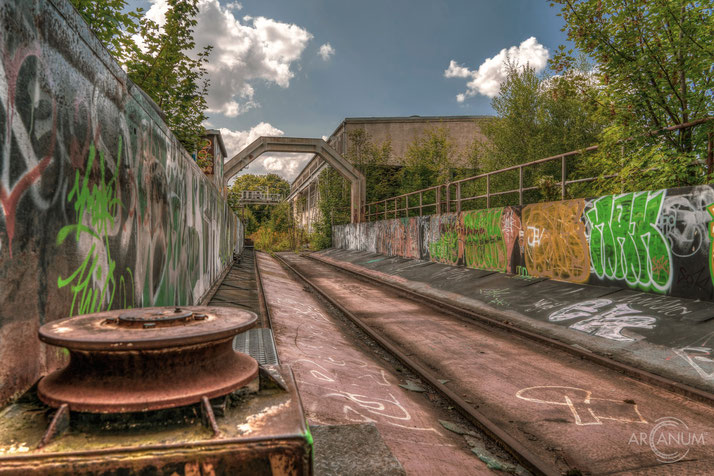Railway Repair Factory "Fields of Green"
The 15,000 square meter site has been deserted for a long time. The saloon car of the last German Emperor was here in 1953. The area of the former Reichsbahn repair shop has been up for sale for years. But so far no interested parties have been found.
The traditional company was closed by Deutsche Bahn AG in 1998. Since then, this vacancy has shaped the north-western part of the quarter, but also testifies to the
decline of the railway system in the city, which was not only a railway junction, but also an important production and repair location.

The four-floor administration and social building was built in the 1960s, but the workshops and warehouses are significantly older. Contamination is suspected on some areas. The railway company wanted to sell the commercially usable property since the closure - so far without success.
A master locksmith founded a small company in 1883, in which carousels were produced. Six years later, the space was no longer sufficient. The rapidly expanding company moved to a different location, to a property that was later taken over by an electronics company.
The founder then left the company, which later became "Gothaer Waggonfabrik AG" (GWF), and opened a new carousel factory but turned back to wagon building later. Around 350 people then found wages and bread in this second wagon construction factory in the city.
After the First World War, the founder gave up his business, and so the "Central European Sleeping Car and Dining Car Company" (Mitropa), founded in 1916, acquired the site in order to set up a workshop there to repair their wagons. The central location and the presence of the appropriate specialist staff were certainly decisive for the choice of location.
The site was equipped with around 700 meters of tracks, a transfer table and a connection to the train station. The factory had a market value of around 900,000 Reichsmarks, and up to 700 people worked in the factory.
The official change of ownership took place on March 23, 1922, more than 100 years ago. Just two years later it had to be expanded; In 1928, Mitropa owned 310 sleeping cars, 271 dining cars and seven saloon cars. All were based on this site and thus always ensured good utilization. When the fleet of wagons was increased in the years that followed, the repair shop reached the limits of its capacity. It was no longer possible to expand the area. A second Mitropa plant was therefore built in Falkensee near Berlin.
During the Second World War, the motto was "wheels are rolling for victory", so hospital and front cars were repaired, in 1944 only with 83 employees. Mitropa was even involved in the "Go 229 flying wing project". The first sample of this "miracle weapon" was created in the carpentry workshop.
The plant survived the devastating bombing raid of February 6, 1945, which reduced the station district to rubble and ash. A few days after the American soldiers marched in, work began again on repairing the dining and sleeping cars. After the Soviets moved in, the plant had to contribute to reparations.
Together with the local railway repair shop and later a tractor vehicle axle factory, two mobile meteorological stations were developed and built for the Soviet Union. The best sleeping and dining cars that could be found in the then Soviet occupation zone were converted for these two trains; in addition, 30 caravans and 45 workshop vehicles were refurbished. In 1948 the company with 325 employees came back into the Mitropa portfolio.
The saloon car of the last German Kaiser, a Soviet trophy in 1945, arrived in 1953 in Mitropa's main workshop to be prepared as an agitation car for the FDJ (Free German Youth). Although there was an attempt to place the wagon under museum protection, the 95,000 marks for the refurbishment could not be obtained.
The utilization of the plant has always been secured over the years. Even mail cars were repaired. There were also some custom-made products: in 1954 the interior of a measuring boat for the Meteorological Institute in Potsdam, and in 1959 the construction of a wagon for the Oberweißbach mountain railway.
In 1964 the plant was incorporated into the Deutsche Reichsbahn and renamed as an RAW. Before the German reunification, the company employed around 400 people, after which the workforce was reduced in a "socially responsible" manner, so that in 1993 there were still 325 people.



















































